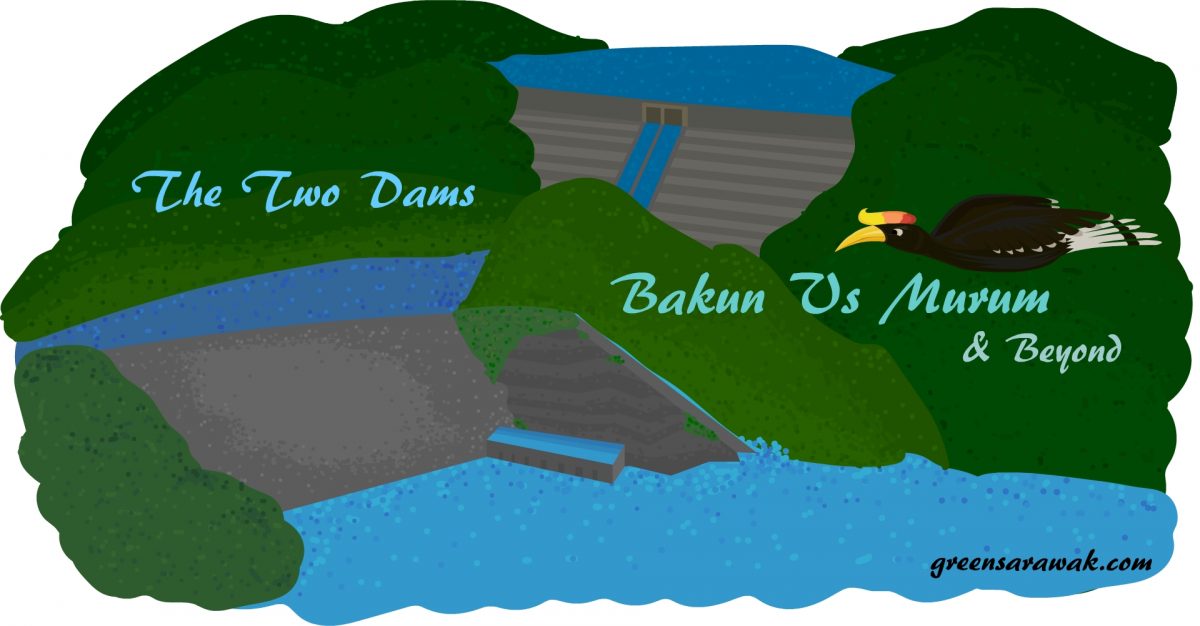In Malaysia, there is many Hydroelectric Power Station spreading across the nation. Knowing that Bakun Dam in Sarawak is the largest in Malaysia, are you wondering which dam is second in place ? The answer is the Murum Dam in Sarawak.
You got it right, This two hydroelectric behemoth have a combined power generation capacity more than the total output of all the other 18 hydroelectric power plants in Malaysia combined. Lets find out more !
Hydroelectric Power
Hydroelectricity is electricity produced from hydro-power or the power of moving water. The water movement energy is captured into movement (kinetic) of a rotating turbine which in turn runs a generator that converts the movement into electric power.
There is many forms of hydroelectric power generation, most commonly found is the hydroelectric dams (conventional hydroelectric power station). The power is extracted from the potential energy generated from the dammed water behind the dams. The higher the difference between the height of the source (water reservoir in the dam) and the water outflow, the higher potential energy it can used to generate power.
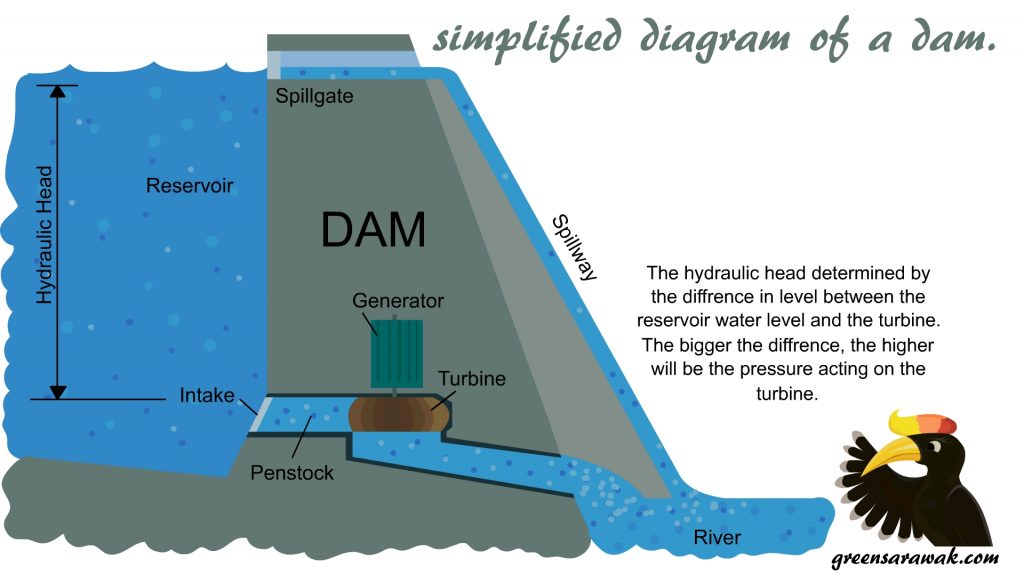
To generate stable amounts of continuous energy, dam must be tall to generate adequate pressure difference to turn a water turbine, and enough reservoir to ensure continuous supply of water to run water turbine, even at times of less rainfall.
To reduce the cost of building large and long walls across an area to impound or store water, dams is usually build near mountain ridge with most of the height of the mountain used as a natural dam walls.
Pros and Cons of a hydroelectric dam
The benefit of a hydroelectric dams:
- Flexibility/Fast Response : being simple in power generation methodology, hydro turbines can be powered up or powered down just by controlling the flow of water into the turbines. It responds faster than starting other type of combustion engines that using steam or gas turbines. It is important as power demands can varies allot over a day, hydroelectric power plants can response to peak demand in a very short time.
- Cheaper Energy : Unlike fuel in a combustion generator, you don’t need to pay each cubic meter of water to generate the similar power. Water is abundant through rainfalls. Hence it is seen as low cost high value clean energy. Usually in 5-10 years of full electricity generation, it can cover the initial cost of construction.
- Low Maintenance : Most of the hydroelectric dams are automated and only require fewer personnel on the site during normal operation, which translated to a low operating labor cost.
- Suitable for Energy Intensive Industry : Some industry requires mass amount of electricity to be operated, for example is an aluminum electrolytic plants (to extract pure aluminum from its ore you need vast amount of electricity for electrolysis, which can translate into 20-40% of the cost of producing aluminum.)
- Natural Battery : The massive reservoirs behind the dams acts a a natural battery of potential energy storing for later uses. Which comparing to other renewable energy such as wind and solar that requires a separate physical battery to store energy to ensure continuity of electricity supply. This cuts down the comparative cost to store energy and reduce the need of physical battery which mostly using dangerous material and rare metals.
The disadvantages of a hydroelectric dams:
- Ecosystem damage : To build a large enough reservoir to impound enough water to sustain a effective power generation, large amount of land behind the dams are submerged under water. Lands are loss, wildlife and people are displaced due to massive flooding.
- Fluctuation in river flow : The downstream river flow will have wide fluctuation of water level over the day corresponding to the intermittent opening of the turbine gates during power generation. More gates will be open during times of high power demand.
- Siltation and sedimentation : River with high water flow can bring silt and suspended sediments from soil erosion far down to the down stream. Building a dam will reduce the effective flow of the water and hence build up sediments over dependent areas causing reduce in dam capacity over time.
- Methane emissions : Dams are considered clean energy by not producing CO2 emissions during energy production, displacing billions of tons of CO2 emissions across the globe in comparing to fossil fuel combustion power station. However, dams in tropical climate have different impact than those in temperate climate. Methane – a more potent green house gases than carbon dioxide – are produced from anaerobic decay of massive amounts of plant material flooded by the reservoir. To reduce methane production, forest of the flooded area need to be clear off.
- Failure risks : A dam failure may cause disaster and massive flood as more than a year worth of rain fall are released in a short time during a catastrophic failure. Newer dams are build with better safety features to reduce catastrophic failure, even in event of earth quakes and storm.
The Hydroelectric Power in Malaysia
Malaysia lies in a tropical climate region is blessed with whole years of abundance rainfall. With vast land, high hills and long river systems, it is nevertheless a suitable ground for dam building and hydroelectric power generation.
In peninsular Malaysia, majority of the dams are located at Sungai Perak and Cameron Highlands. In Sarawak, Two dams located at Sungai Rajang tributaries and one dam located at Batang Ai river.
Below is the top 10 list of Hydroelectric Power Plants in Malaysia, ranked by install capacity (peak power generation).
- 2400MW – Bakun Dam (Balui River, Sarawak)
- 944MW – Murum Dam (Murum River, Sarawak)
- 600MW – Pergau Dam (Sungai Pergau, Kelantan)
- 400MW – Sultan Mahmud Power Station or Kenyir Dam (Sungai Terengganu, Terengganu)
- 372MW – Ulu Jelai Power Station (Sungai Bertam, Cameron Highlands, Pahang)
- 348MW – Temenggor Power Station or Temengor Dam (Sungai Perak, Perak)
- 150MW – Sultan Idris II (Cameron Highlands, Pahang)
- 120MW – Sultan Azlan Shah Kenering Power Station (Sungai Perak, Perak)
- 100MW – Sultan Yusof Jor Power Station (Cameron Highlands, Pahang)
- 100MW – Batang Ai Dam (Batang Ai River, Sarawak)
The top two dams have the combined power generation capacity more that the total power generated from the others dams in Malaysia combined.
The Hydroelectric Power in Sarawak
In Sarawak, hydroelectric is the most promising alternative renewable energy source due to abundance of water with an annual precipitation of about 4000mm.
Furthermore there is many suitable sites for hydroelectric dam building. There is many natural occuring basins in the mountaineous inlands of Sarawak. This basins forms a huge catchment areas suitable for building huge dam reservoirs. The notable basins are the various Rajang basins (which holds by the Bakun dam, Murum dam and the future Baleh dam) and other smaller basins like baram basins and limbang basins.
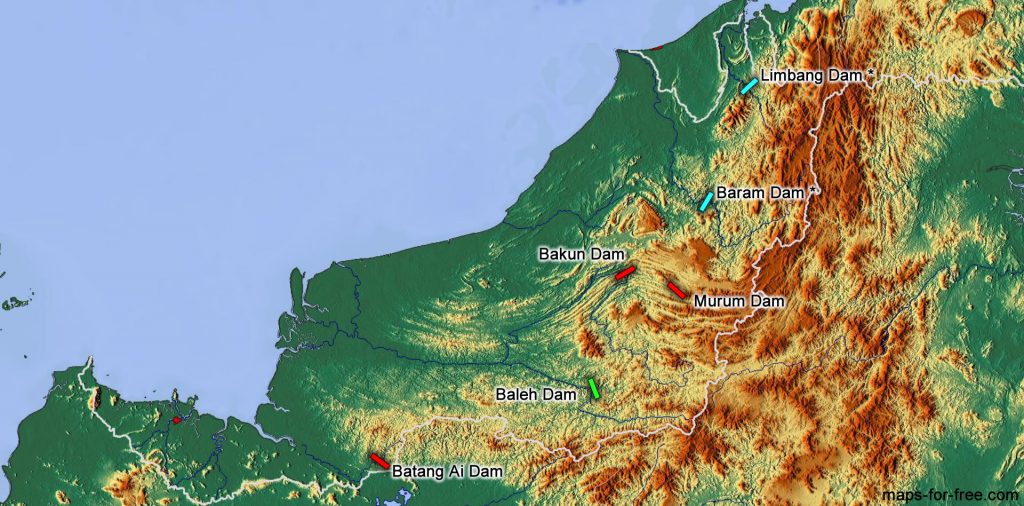
Basins are areas that are surrounded by higher grounds, forming a natural bowl like structure that water have limited outlet to escape. While the catchment area is area where all rainfall is collected, which corresponding to the draining rivers and tributaries. For example of Bakun Dam, it is located at the main outlet of water from the mountains (catchment area) via balui river. Due to its narrow outlet and large basin, it becomes a great potential to be a effective dam.
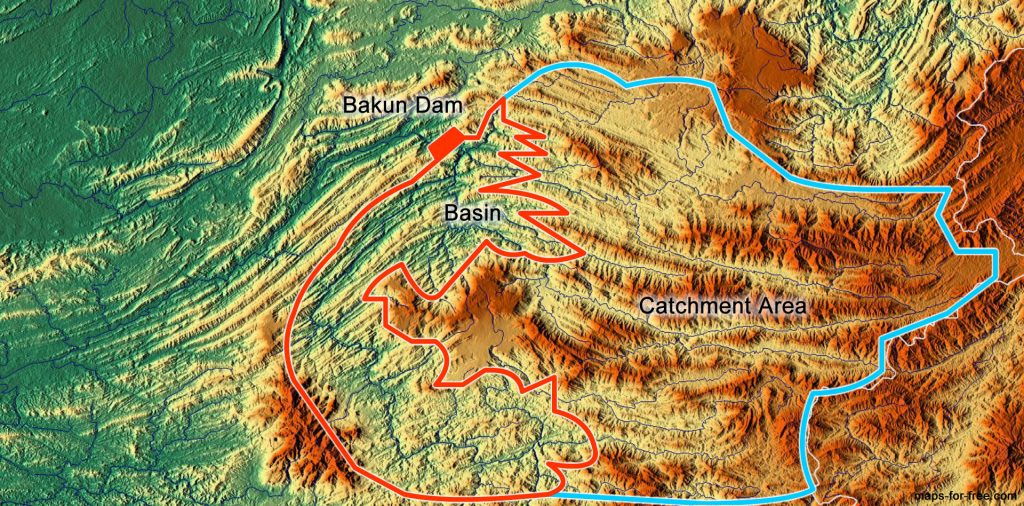
Dams in Sarawak is planned not only for power generation, but act as flood control, irrigation and supply of drinking water.
The first hydroelectric dam in Sarawak is the Batang Ai Hydroelectric Power Plant. The construction started in 1981 and completed in 1985, have a capacity of 108MW. After 30 years, it is still contributing clean and reliable energy.
SCORE
Sarawak Corridor of Renewable Energy (SCORE) was launched on 11 February 2008. It is one of five economic development corridors created by the Federal Government of Malaysia as part of its ambitious plan to stimulate investment-led growth in traditionally rural areas.
The focus of the Corridor is to attracts investors to a designated developing area (spanning area of 70,000 square kilometers) with industry that gives the highest economic impact in Sarawak. The 10 priority industry is Oil-based, Aluminum, Steel, Tourism, Palm-oil, Timber-based, Livestock, Aquaculture, Marine Engineering and Glass Industry.
In the long term it will move the state economy up, achieve higher per-capita income, enhance quality of life, achieve balanced regional development and eradicate poverty.
Under the Sarawak SCORE development plan, the implementation of Hydroelectric Power Dams are given emphasis (focus on growing the energy sector) to cater for future domestic, commercial and industry electricity demands in Sarawak.
Murum Dam is the Sarawak Energy’s first hydropower facility launched under Sarawak SCORE initiative. The second hydropower plant under the same initiative is the Baleh Hydroelectric Project which planned to be commenced in October 2018. Other feasible hydropower projects includes Limbang 150MW hydroelectric Power and Barang 1,000MW hydroelectric power.
The Bakun Dam
The Bakun Dam is an embankment dam (dam shaped like a bank or hill) on the Balui River, a tributary of the Rajang River. The construction started in 1996 and operating in 2011.
With the height of 205m and length of 750m, it is the second tallest concrete-faced rockfill dam in the world. With 8 turbines (Francis turbine ) of of 300MW each, it can generate 2,400MW at full operation.
The reservoir have an estimated surface area of 695 km2, with a catchment area (area of land where water is collected and drained) of 14,750 km2.
The Murum Dam
The Murum Dam is a Roller-compacted concrete gravity dam on the Murum River, which is the uppermost part of Rajang River basin, 70Km from the Bakun dam downstream.
A Gravity dam is a dam utilizing the weight of the building material (concrete) to resist the horizontal pressure of water pushing against it.
The construction begins in 2008 and started operating in 2014. It had height of 141m and length of 473m. With 4 turbines (Francis turbine ) of of 236MW each, it can generate 944MW at full operation.
The reservoir have an estimated surface area of 245 km2, with a catchment area of 2,750 km2.
The Scale of the Reservoir at Bakun and Murum
The scale of the reservoir can be clearly seen from the satellite imagery. The area is flooded and initially creating a dark colored reservoir seen from the satellite due to dead and decaying plantation, however over time when silts and sediments sets in, it creates a pale looking lake from the satellite imagery.
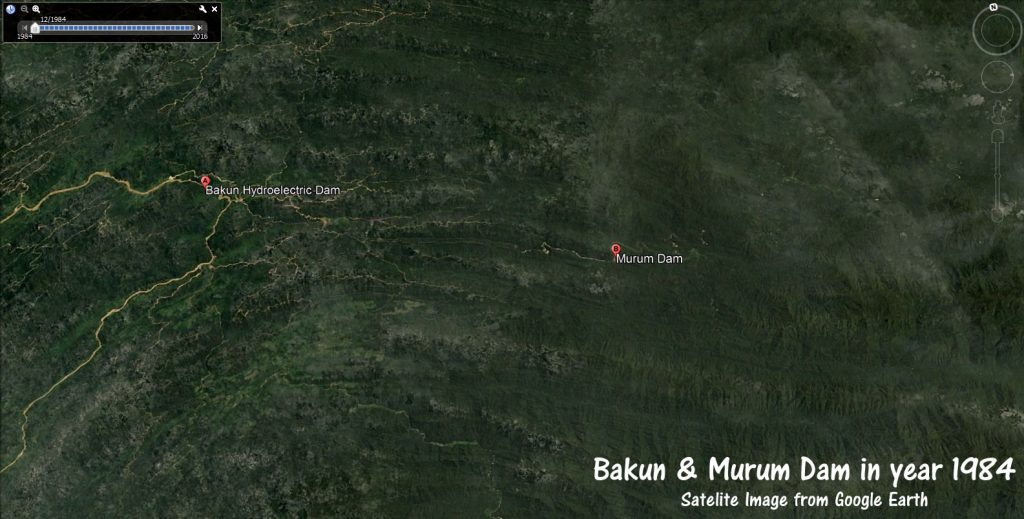
It was a dense forest back then. The two rivers being the tributary of Majestic Rajang River which connects various native settlements of mainly Dayaks.
The Bakun dam started its construction in 1996.
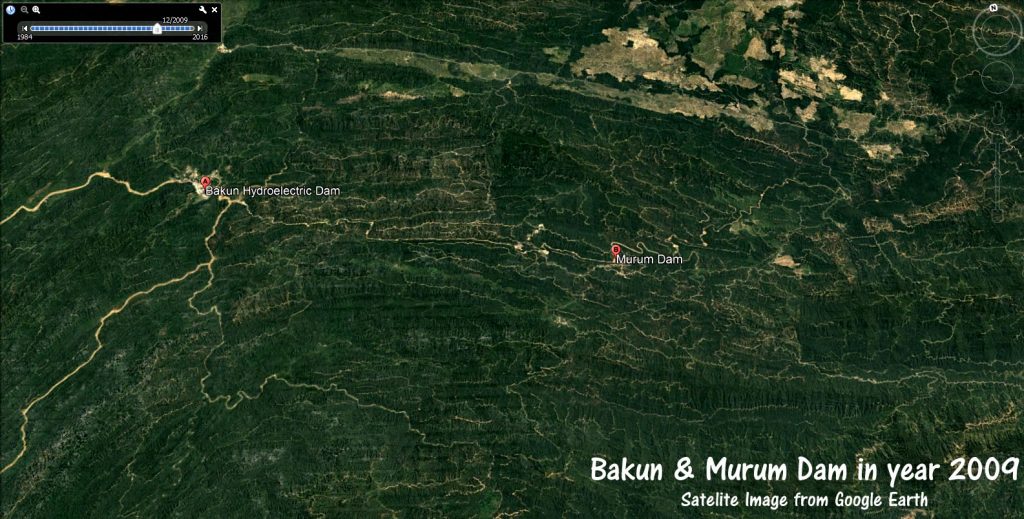
During the constructing of the Bakun dam, a second dam is also started its construction over the upper Rajang Basin. The Murum Dam starts its construction in 2008.

The Bakun dam flooding started in 2010. In 2012, the reservoir grew to a significant size that can be spot from the satellite imagery.

The Murum dam starts to fill its reservoir in 2013 and starts its operation in 2014. The satellite imagery showing the color difference in both reservoir which corresponding to the submerged entities and sediments.

Both reservoir is still increasing in size over time.
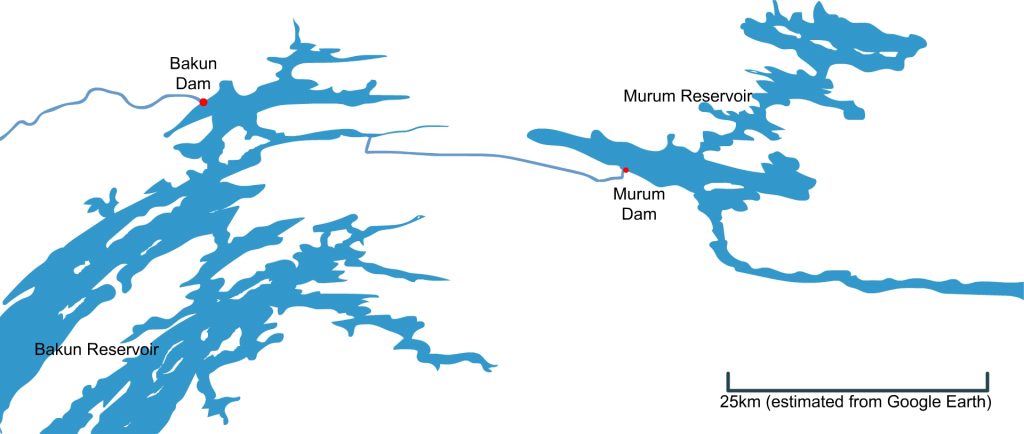
The two dams may cause a lost of 1000km2 of rainforest land (nearly one and half of a land area of singapore) that is permanently submerged underwater. Over time soil erosion and siltation of the reservoir create much concern.
The Baleh Hydroelectric Project
The quest of clean renewable energy doesn’t stops with Batang Ai, Bakun and Murum. The next hydroelectric project is the Baleh Hydroelectric Project which impound a hydroelectric dam at the Baleh River, about 95 km from its confluence with the Rajang River in the Kapit Division. It is the third dam involving the tributary of Rajang River.
The Baleh Hydroelectric dam is planned to includes a 188m high Concrete Faced Rockfill Dam, with total of 1,285MW installed capacity via 5 turbines. Once completed it will be second in installed capacity after Bakun dam.
The reservoir have an estimated surface area of 588 km2, with a catchment area of 5,625 km2. It is double the surface area and catchment area in compared to the Murum reservoir.
The project is estimated to be commenced in October 2018, with plan to be commission in 2025. It is also dub as “one of Sarawak’s largest infrastructure projects”.
There are many more dam project in the future in the quest for green energy in Sarawak. Whats their benefit or impact to the nature and socioeconomic ? lets stay tune!

